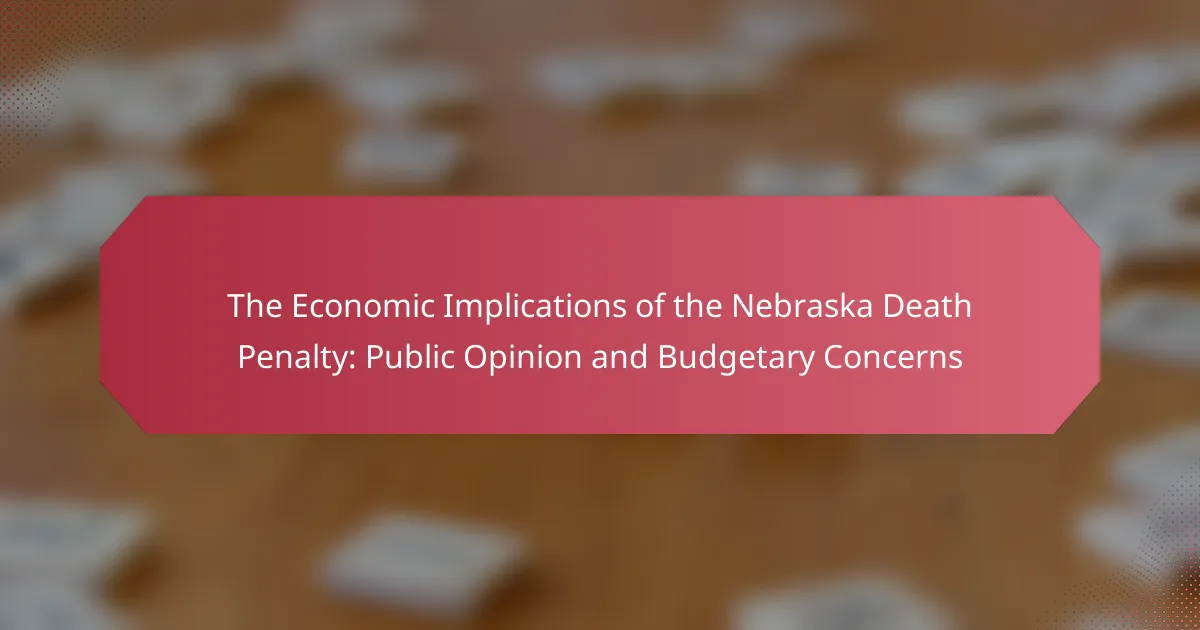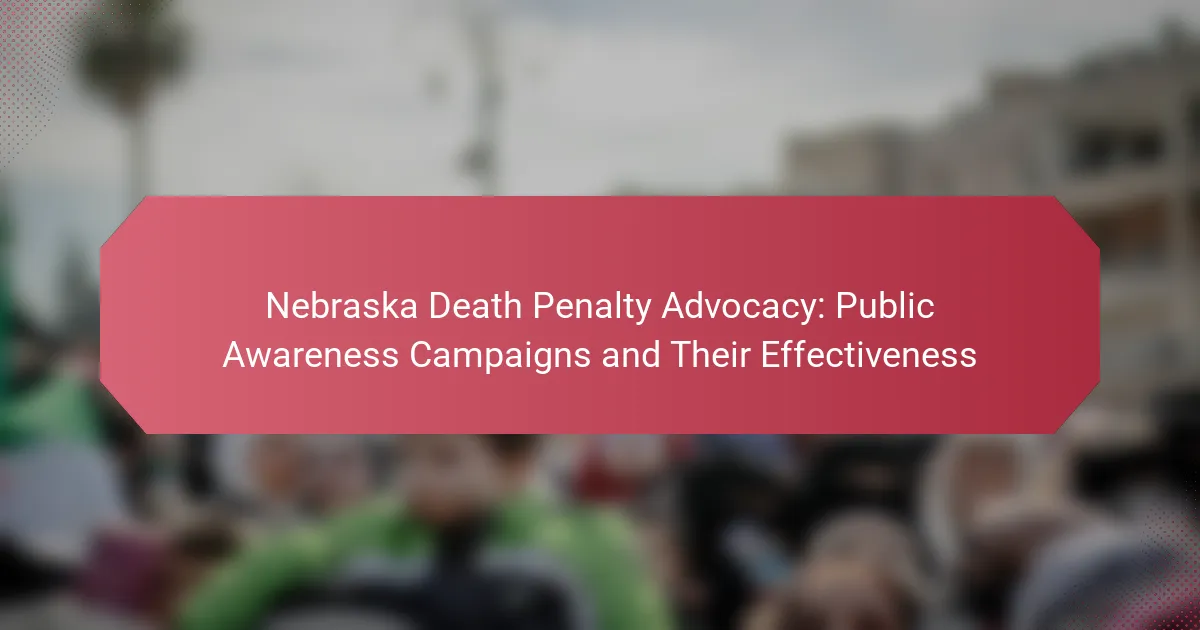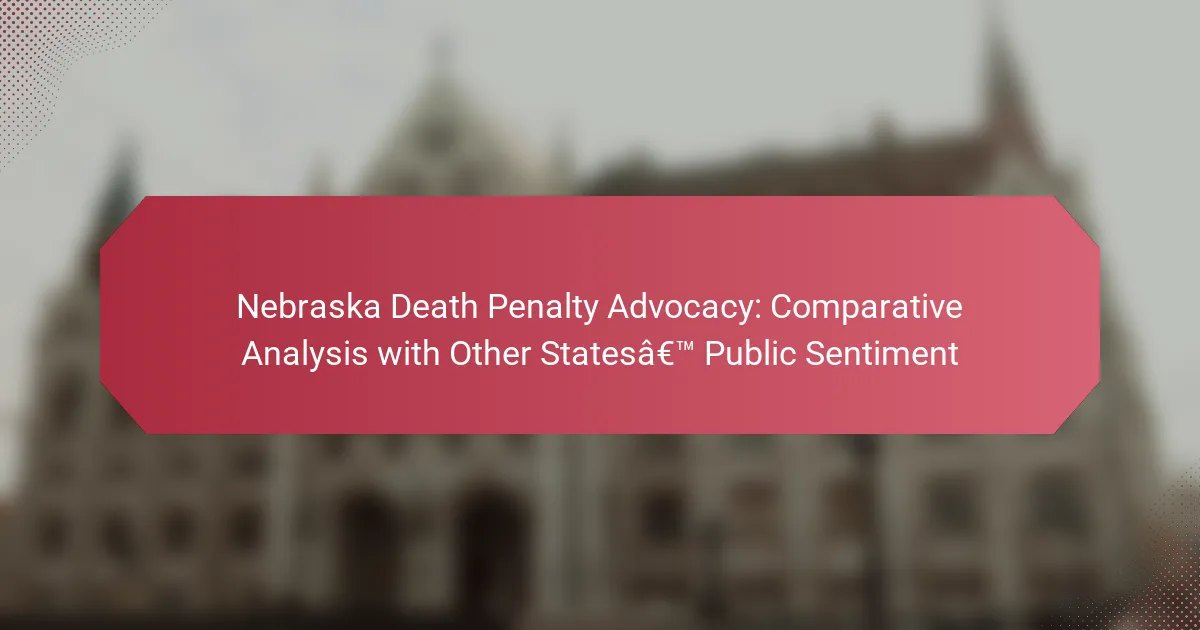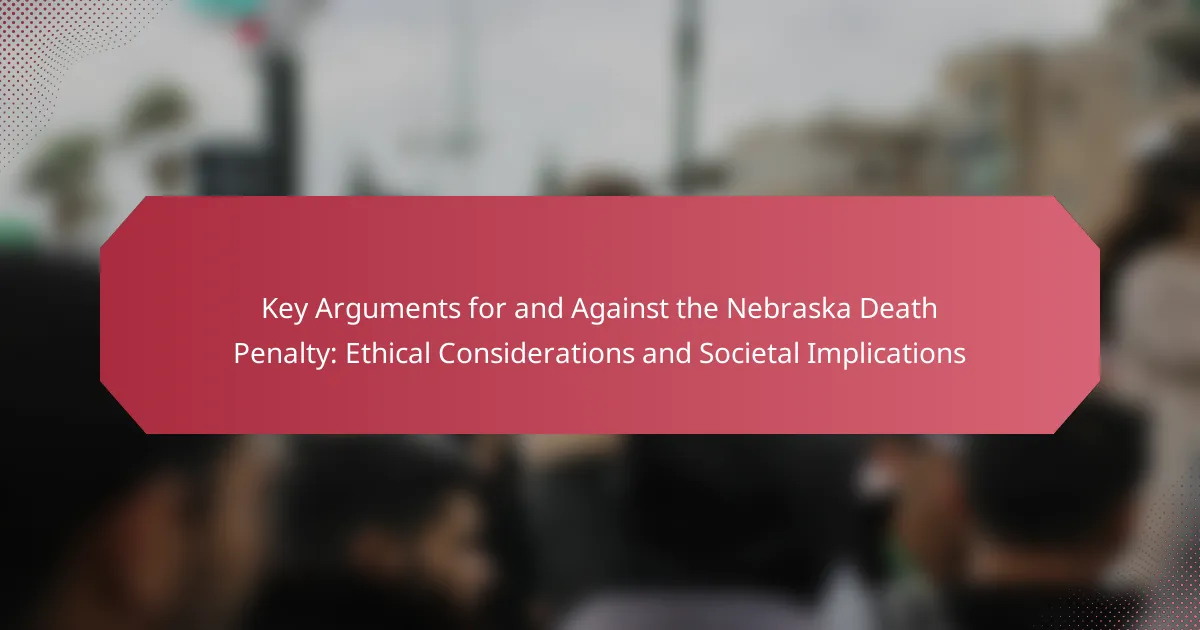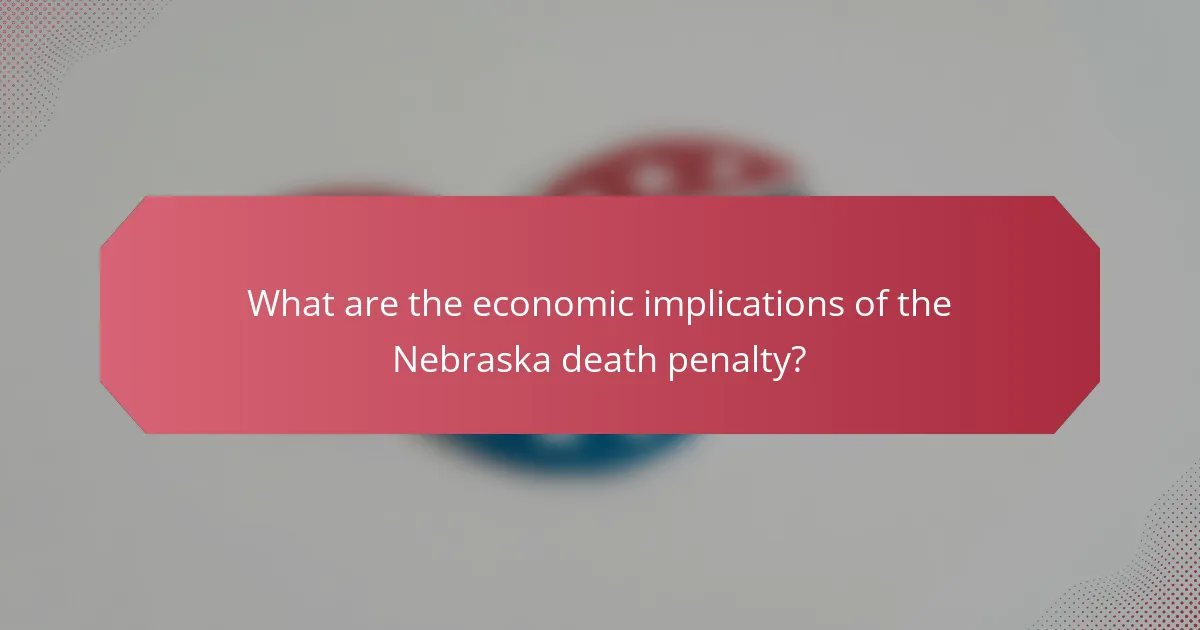
What are the economic implications of the Nebraska death penalty?
The economic implications of the Nebraska death penalty include high costs associated with legal proceedings and incarceration. Studies indicate that death penalty cases are significantly more expensive than life imprisonment cases. For example, a 2015 report from the Nebraska Legislative Fiscal Office estimated that the death penalty costs the state approximately $1.2 million per execution. This includes costs for trials, appeals, and long-term incarceration. Additionally, the state incurs ongoing expenses for housing inmates on death row, which is higher than for those serving life sentences. Public opinion also plays a role, as many citizens express concerns about the financial burden of capital punishment. These factors contribute to ongoing debates regarding the efficacy and morality of the death penalty in Nebraska.
How does the death penalty impact state budgets?
The death penalty significantly impacts state budgets by increasing legal and incarceration costs. States incur substantial expenses for trials, appeals, and lengthy incarceration periods for death row inmates. For instance, a 2011 study in California found that the death penalty costs taxpayers approximately $184 million annually. This includes costs for legal representation, jury selection, and post-conviction appeals, which are more extensive than for non-death penalty cases. Additionally, maintaining death row facilities adds further financial burden. Overall, the financial implications of the death penalty can strain state budgets, diverting funds from other essential public services.
What are the costs associated with capital punishment cases?
The costs associated with capital punishment cases are significantly higher than those for non-capital cases. Studies indicate that the average cost of a capital case can exceed $1 million. This includes expenses for pre-trial, trial, and post-conviction processes. Legal representation for capital cases is more expensive due to the complexity and length of the trials. Additionally, costs for incarceration on death row are higher than for regular prison populations. A report from the Nebraska Legislative Fiscal Analyst highlighted these financial burdens. The state of Nebraska has faced ongoing budgetary concerns related to these expenses.
How do these costs compare to life imprisonment alternatives?
The costs of the death penalty are significantly higher than life imprisonment alternatives. Studies indicate that death penalty cases can cost up to three times more than life sentences. This includes expenses for legal representation, trials, and prolonged incarceration. In Nebraska, the average cost of a death penalty case is approximately $1.2 million. Conversely, a life imprisonment sentence typically costs around $500,000. The financial burden stems from extensive legal processes and appeals associated with capital punishment. Additionally, states with the death penalty often face increased administrative costs. Overall, the economic implications favor life imprisonment as a more cost-effective option.
What role does public opinion play in funding the death penalty?
Public opinion significantly influences funding for the death penalty. When public support for the death penalty is high, legislators are more likely to allocate funding for its implementation. Conversely, when public sentiment shifts towards opposition, funding can be reduced or eliminated. For instance, a 2019 Gallup poll indicated that only 56% of Americans supported the death penalty, the lowest level in decades. This decline in support can lead to budgetary concerns, as states may reconsider the financial implications of maintaining capital punishment. Additionally, states with strong opposition may redirect funds to alternative sentencing options. Therefore, public opinion directly impacts the financial resources dedicated to the death penalty.
How do citizens perceive the financial aspects of the death penalty?
Citizens generally perceive the financial aspects of the death penalty as costly. Studies indicate that death penalty cases require significantly more resources than life imprisonment. For instance, a 2013 study by the Nebraska Legislative Fiscal Office found that the death penalty costs approximately $1.5 million more per case than life sentences. Public opinion often reflects concern over these high costs. Many citizens believe that funds allocated to capital punishment could be better spent on other public services. Additionally, some surveys show that a majority of citizens support alternatives to the death penalty due to financial considerations. Overall, the perception is that the economic burden of the death penalty outweighs its benefits.
What surveys or studies reflect public sentiment on this issue?
Recent surveys indicate varying public sentiment on the Nebraska death penalty. A 2021 poll by the Nebraska Coalition to End the Death Penalty revealed that 61% of Nebraskans oppose the death penalty. The study highlighted concerns over its financial implications and effectiveness in deterring crime. Additionally, a 2020 survey conducted by the University of Nebraska-Lincoln found that 52% of respondents favored alternatives to capital punishment. These studies reflect a significant shift in public opinion regarding the economic and ethical considerations surrounding the death penalty in Nebraska.
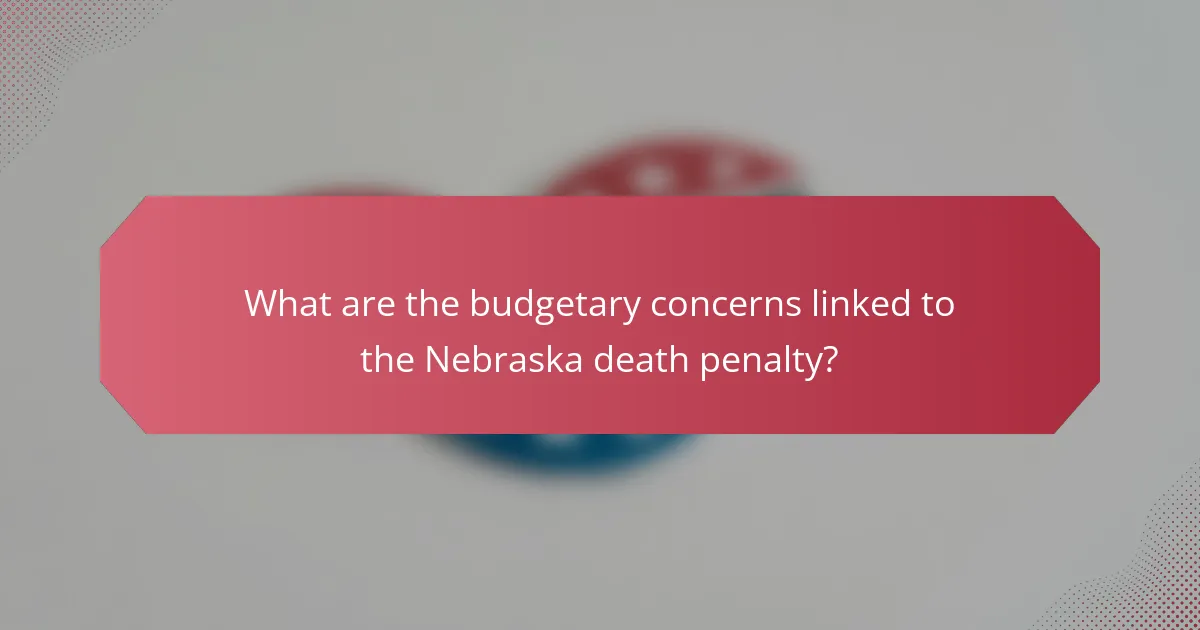
What are the budgetary concerns linked to the Nebraska death penalty?
The budgetary concerns linked to the Nebraska death penalty include high legal costs and lengthy appeals. Legal proceedings for death penalty cases are significantly more expensive than those for life sentences. A 2015 report indicated that Nebraska’s death penalty cases cost taxpayers approximately $14 million per execution. This includes costs for attorneys, expert witnesses, and extended trial durations. Additionally, the state incurs costs for housing inmates on death row. The financial burden impacts state budgets and resource allocation. These concerns contribute to ongoing debates about the viability of the death penalty in Nebraska.
How do legal proceedings influence overall costs?
Legal proceedings significantly increase overall costs due to various factors. The complexity of legal processes often requires extensive resources. This includes attorney fees, court fees, and expert witness costs. In death penalty cases, these expenses can escalate further. A study by the Nebraska Commission on Public Advocacy found that death penalty cases cost approximately 10 times more than non-death penalty cases. Additionally, prolonged trials and appeals contribute to higher costs. The financial burden on the state includes both prosecution and defense expenses. Overall, legal proceedings create substantial financial implications for the justice system.
What are the average expenditures for trials and appeals in death penalty cases?
The average expenditures for trials and appeals in death penalty cases typically range from $1 million to $3 million. This figure includes costs associated with pre-trial, trial, and post-conviction processes. A study by the National Academy of Sciences indicated that death penalty cases are significantly more expensive than non-death penalty cases. The costs stem from lengthy legal processes and the need for specialized legal representation. In some states, the financial burden can exceed $5 million when factoring in incarceration and execution costs. These expenditures raise important budgetary concerns for states considering the death penalty.
How do these expenditures affect the judicial system’s resources?
Expenditures on the death penalty significantly strain the judicial system’s resources. These costs include legal fees, incarceration, and execution expenses. In Nebraska, the comprehensive costs of capital cases can reach millions of dollars. This financial burden diverts funds from other critical areas within the judicial system. Resources that could support public defense, rehabilitation, and crime prevention are often reallocated. Consequently, the overall efficiency of the judicial system may decline. A study by the Nebraska Commission on Public Advocacy highlights these budgetary concerns. The report emphasizes that capital punishment cases consume disproportionate resources compared to non-capital cases.
What are the indirect economic impacts of the death penalty?
The indirect economic impacts of the death penalty include increased legal costs and prolonged judicial processes. States incur significant expenses for pre-trial, trial, and post-conviction phases. These costs often exceed those associated with life imprisonment. For example, a 2011 study in California showed that the death penalty system costs taxpayers over $137 million per execution. Additionally, there are costs related to incarceration on death row, which typically requires more resources than general prison populations. Public resources are diverted from other areas, such as education and healthcare, due to the financial burden of capital cases. Furthermore, the death penalty can deter investment and tourism, as potential investors may view it as a sign of an unstable legal environment.
How does the death penalty affect local economies and employment?
The death penalty affects local economies and employment by diverting funds from community services to legal and correctional expenses. States that maintain the death penalty often incur higher costs related to lengthy legal processes and incarceration. For example, a study from the Nebraska Legislative Fiscal Office indicated that death penalty cases can cost up to $1.7 million more than life imprisonment cases. These financial burdens can limit funding for education and public safety, which are crucial for local economic growth. Additionally, communities may experience reduced job opportunities in sectors that depend on stable public funding. The allocation of resources to capital punishment can hinder overall economic development and employment rates in affected areas.
What are the potential long-term financial repercussions for the state?
The potential long-term financial repercussions for the state include increased legal costs and prolonged incarceration expenses. Implementing the death penalty often leads to lengthy trials and appeals. These processes can significantly drain state resources. A study by the Nebraska Legislative Fiscal Office indicated that death penalty cases cost approximately 10 times more than life imprisonment cases. Additionally, maintaining death row facilities incurs ongoing operational costs. Over time, these financial burdens can impact other state-funded programs. The cumulative effect may lead to budget reallocations or increased taxes. This financial strain can hinder the state’s ability to invest in essential services like education and healthcare.
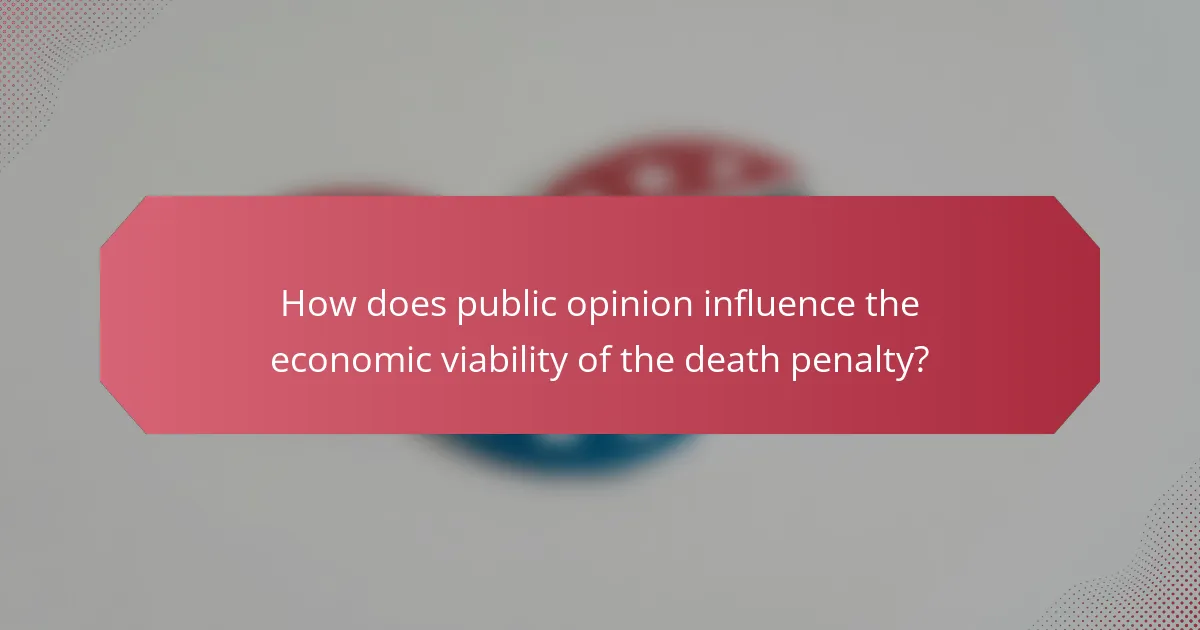
How does public opinion influence the economic viability of the death penalty?
Public opinion significantly influences the economic viability of the death penalty. When public support for the death penalty declines, lawmakers may reconsider its funding and implementation. This shift can lead to reduced budgets for capital punishment cases. For instance, states with strong opposition often allocate fewer resources to death penalty trials and appeals. Public sentiment can also affect the political landscape, prompting elected officials to prioritize cost-effective alternatives. Research shows that states with high public support for the death penalty tend to allocate more funds to its enforcement. Conversely, as public opinion shifts towards abolition, budgetary concerns often lead to the repeal of death penalty statutes. This demonstrates a clear link between public perception and the financial implications of capital punishment policies.
What are the trends in public support for the death penalty in Nebraska?
Public support for the death penalty in Nebraska has fluctuated over the years. Recent polls indicate that support has decreased compared to previous decades. For instance, a 2021 survey showed that only 57% of Nebraskans favored the death penalty, down from 75% in the late 1990s. This trend reflects a growing sentiment for alternatives to capital punishment. Additionally, factors such as high costs associated with the death penalty have influenced public opinion. In 2015, Nebraska lawmakers passed a bill to abolish the death penalty, although it was later overturned by a referendum. Overall, the trend indicates a gradual decline in support for capital punishment in the state.
How have recent events shifted public opinion regarding capital punishment?
Recent events have significantly shifted public opinion regarding capital punishment. Increasing awareness of wrongful convictions has led to growing skepticism about the death penalty’s reliability. High-profile cases of exonerated individuals have garnered media attention, influencing public sentiment. Additionally, financial analyses indicate that capital punishment is more costly than life imprisonment. These economic concerns have prompted discussions about the practicality of maintaining the death penalty. Surveys show a rising preference for alternatives to capital punishment among the population. Overall, recent developments have contributed to a more critical view of the death penalty in society.
What implications does changing public opinion have on budget allocations?
Changing public opinion significantly influences budget allocations. When public sentiment shifts, policymakers often respond by reallocating funds to align with constituents’ preferences. For instance, increased public support for certain social programs can lead to higher budget allocations for those initiatives. Conversely, declining support for controversial programs may result in budget cuts. Historical examples show that public opinion can sway legislative priorities, impacting funding decisions. In Nebraska, changing views on the death penalty have prompted discussions about reallocating resources from capital punishment to other areas, such as education or mental health services. This demonstrates how public sentiment directly affects budgetary choices and priorities.
What practical insights can be derived from the economic implications of the Nebraska death penalty?
The economic implications of the Nebraska death penalty suggest significant financial burdens on the state. Legal costs associated with death penalty cases are substantially higher than for non-death penalty cases. For instance, a 2015 study indicated that death penalty cases can cost taxpayers up to $1.5 million more than life imprisonment cases. Additionally, the prolonged legal process and appeals contribute to increased expenses. The costs associated with incarceration on death row also add to the financial strain. These insights highlight the need for policymakers to consider economic factors when discussing the future of the death penalty in Nebraska.
How can policymakers balance public opinion and budgetary concerns effectively?
Policymakers can balance public opinion and budgetary concerns by engaging in transparent communication and data-driven decision-making. They should conduct surveys to gauge public sentiment regarding the death penalty. This allows them to understand constituents’ views and concerns. Budgetary analyses should accompany these surveys to assess the financial implications of the death penalty. For instance, a report from the Nebraska Legislative Fiscal Office indicated that the death penalty incurs significantly higher costs than life imprisonment. By presenting clear data on costs alongside public opinion, policymakers can make informed choices that reflect both fiscal responsibility and community sentiment. Engaging stakeholders in discussions can also foster compromise solutions that address both perspectives.
What strategies can be employed to optimize funding related to the death penalty?
It is essential to implement targeted strategies to optimize funding related to the death penalty. One strategy is to conduct a comprehensive cost-benefit analysis of the death penalty versus life imprisonment. This analysis can highlight the financial burden of capital cases, which often exceed the costs of alternative sentences.
Another strategy involves reallocating existing resources from less effective crime prevention programs to support death penalty cases. This can ensure that funds are used more efficiently. Engaging in public awareness campaigns can also help garner community support, potentially influencing policymakers to prioritize funding.
Additionally, forming partnerships with nonprofit organizations can provide supplemental funding and resources for legal defense. These partnerships can enhance the quality of representation in capital cases. Lastly, advocating for legislative changes to streamline the appeal process can reduce the prolonged costs associated with death penalty cases.
These strategies are supported by research indicating that states with more efficient legal processes save significant amounts on capital punishment expenditures.
The primary entity of this article is the Nebraska death penalty, which is examined through its economic implications and the influence of public opinion on budgetary concerns. The article provides an analysis of the high costs associated with capital punishment, including legal proceedings, incarceration, and ongoing expenses, which significantly exceed those of life imprisonment alternatives. It discusses how public sentiment regarding the death penalty impacts funding decisions and highlights recent trends in public opinion that reflect growing skepticism about its financial viability. Additionally, the article explores potential long-term financial repercussions for the state and offers insights into strategies for optimizing funding related to the death penalty.
